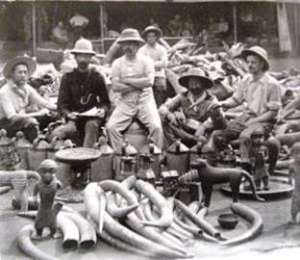
“The trustees of the British Museum have become the world’s largest receivers of stolen property, and the great majority of their loot is not even on public display."
Geoffrey Robertson, Who owns history?
When I heard the news that the Director of the British Museum, Hartwig Fischer, had expressed support for Black Lives Matter, I thought somebody must be playing a joke, a nasty one at that. The director of the imperialist citadel of looted African and Asian artefacts expressing solidarity with those revolted by the many racist killings of African Americans, Africans and other Black peoples in the last decades and, specifically by the recent cruel murder of George Floyd by a racist policeman in Minneapolis, Minnesota, U.S.A?
Yes, in a statement posted on the website of the British Museum, the director, Hartwig Fischer, posted a blog post in which he mentioned Black Lives Matter and George Floyd and declared: ‘ ’The British Museum stands in solidarity with the British Black community, with the African American community, with the Black community throughout the world . We are aligned with the spirit and soul of Black Lives Matter everywhere.’’ Fischer also added: ‘’I hope that we will find the right ways to allow the museum to better reflect our societies and our complex, contentious and blended histories, and become more than ever a theatre of human connection. (1)
Anyone who knows a little bit about the British Museum and the millions of looted artefacts it has been keeping from Africa, Asia, the Americas, mostly stolen and plundered by the conquering violent colonial armies, will be shocked by this blatant hypocrisy.
The example of violent European looting usually discussed in the literature is the notorious Benin invasion in 1897 by a British Expedition force, called, the Punitive Expedition that attacked the Kingdom of Benin, (now part of Nigeria and not to be confused with Republic of Benin, a former French colony), stole some 4000 Benin artefacts from the palace of Oba Ovonramwen ,killed hundreds of innocent children, women and men, burnt Benin City and sent the king into exile. (2) The British sold some of the artefacts to Germans and other Europeans and kept the rest in British museums where the Benin bronzes are to be found today. The British Museum has some 700 pieces and the Ethnology Museum/Humboldt, Berlin, Germany has some 500 pieces. (3)
Ever since the nefarious invasion, the people of Benin have been asking for the return of their artefacts but have received either no response or insulting comments on the inability of Nigerians to look after the Benin artefacts and the lack of adequate museums in Nigeria. Denigrating responses and racist arguments have characterised the reactions of British and other Western museums, led by the venerable British Museum, in their relationship to Africans and other non-European peoples. (4)
This then is the background on which the British Museum now pretends to ‘stand in solidarity with the British Black community, with the African American community, with the Black community throughout the world’.
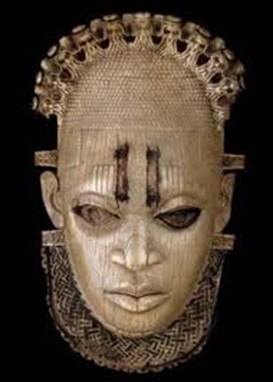
Queen-Mother Idia, Benin, Nigeria, now in British Museum, London, United Kingdom. Will she finally be allowed to return home in Benin City from British exile since 1897? Will the British play the same game as they played when Nigeria asked for the sculpture for FESTAC?
Does the director of the British Museum expect us to believe in his hypocritical words of solidarity with African peoples, African American and Black people all over the world who are victims of racist violence and oppression? It is clearly the lack of diversity at the upper echelon of the British Museum, at least at the level of the advisers of the director, that has led to the failure of this statement by Hartwig Fischer, intended to demonstrate support but finally demonstrating lack of sincerity, empathy and solidarity.
The British Museum as well as other British and Western museums have all contributed to the racist atmosphere in the world that makes it possible for others not to consider black people as human beings entitled to the same rights as all others. The museum could look at some of the racist views of its directors and curators that reinforced views on the alleged inferiority of African people and the corresponding superiority of Europeans. Here are a few examples of the views expressed by Thomas A Joyce, former director in the British Museum:
Mentally the negro is inferior to the white, The remark of F. Manetta, made after a long study of the negro in America, may be taken as generally true of the whole race: “the negro children were sharp, intelligent and full of vivacity, but on approaching the adult period a gradual change set in.
In certain of the characteristics mentioned above the negro would appear to stand on a lower evolutionary plane than the white man, and to be more closely related to the highest anthropoids.
For the rest, the mental constitution of the negro is very similar to that of a child, normally good-natured and cheerful, but subject to sudden fits of emotion and passion during which he is capable of performing acts of singular atrocity, impressionable, vain, but often exhibiting in the capacity of servant a dog-like fidelity which has stood the supreme test. Given suitable training, the negro is capable of becoming a craftsman of considerable skill, particularly in metal work, carpentry and carving.
Cannibalism is found in its simplest form in Africa. In that continent the majority of cannibal tribes eat human flesh because they like it, and not from any magical motive or from lack of other animal food. In fact it is noticeable that the tribes most addicted to this practice inhabit just those districts where game is most plentiful.(6)Du Bois described the views of Joyce as ridiculous but Joyce was engaged as expert to lecture British colonial administrators on ’native races. (5)
Joyce wrote the official guide to the ethnographical collections of the British Museum (1910).and was honorary secretary of the Royal Anthropological Institute in 1903-13, first as vice-president, and then president (1931-33).Joyce was president of the Anthropological Section of the British Association in 1934.In an entry in the 1911 Encyclopaedia Britannica, volume 1 on Africa, Joyce wrote inter alia, the following:
Africa, with the exception of the lower Nile valley and what is known as Roman Africa), is, so far as its native inhabitants are concerned, a continent practically without a history, and possessing no records from which such a history might be reconstructed
The negro is essentially the child of the moment; and his memory, both tribal and individual, is very short.
A statement issued by the Victoria and Albert Museum entitled Black Lives Matter: Race and Equality at the V&A is not much better.(6)
The Victoria and Albert Museum as well as universities of Cambridge, Edinburgh and other institutions in Britain and the Western world are holding thousands of precious Ethiopian manuscripts, crosses, tabots and other treasures that were looted in 1868 at Magdala by a British invasion force under the command of Sir Robert Napier. The Ethiopian Emperor, Tewodros II committed suicide rather than fall into the hands of invading British army. The son of the Emperor, Prince Alemayehu was abducted by the British and brought to Britain where he died in 1879 at the early age of nineteen years. (7)
 Crown of Tewodros, Ethiopia, now in Victoria and Albert Museum, London
Crown of Tewodros, Ethiopia, now in Victoria and Albert Museum, London
Crown of Tewodros II, Ethiopia, looted at Magdala in 1868 now in Victoria and Albert Museum, London
Tristram Hunt and his people at the Victoria and Albert museum, like many Western Museum officials, have become past masters in producing statements that either do not tell the full story or present a slant that effectively prevents the reader from getting a full picture or the whole story. (8)
Most of the text is merely to show the good work that museum is doing and the credentials of Tristram Hunt as somebody who has always opposed racism and oppression. Nobody can doubt that they are producing interesting pieces by experts. Tracing the links of some of the objects in the museum to slave owners or connections to slave owners is commendable. Short statements on the Maqdala collection and Asante gold weights are welcome although it would seem to us that instead of talking about Asante gold weights they could have spoken about the many Asante gold artefacts that are in their museum and elsewhere in Britain. It is also encouraging to read: ’We want to bring a new urgency and transparency to the colonial histories connected to V&A collections and British cultural history. This work must continue so that the past is confronted, understood and reflected upon’.
The statement of the Victoria and Albert Museum concludes: ‘We want to work closely with our staff, audiences and communities, and use the V&A platform to create a space for discussion about race, equality and injustice as an institution that welcomes and represents all. For a museum born of the colonial moment with a custodianship of the legacies of that history, it is particularly important how we learn and understand again, and again.’
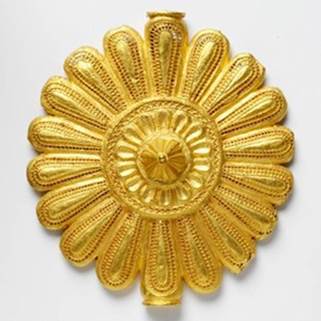 726201865452 image005
726201865452 image005
Pectoral disc. Kumasi, Ghana, now in Victoria and Albert Museum, London, United Kingdom
It appears from the text that Victoria and Albert considers that displaying looted artefacts and relating them to the colonial past of the museum exhausts much of the required functions. They want to tell the history of Ethiopia and show its glorious past and achievements but it does not occur to them that Ethiopians may want to tell their own history with their own artefacts that have been hijacked and now remain in museums such as the Victoria and Albert Museum and the British Museum. For them London appears to be the natural environment of the Ethiopian treasures. There is in the text not a word about restitution nor about the fact that the museum has rejected Ethiopian request for restitution of the looted artefacts and to the fact that Ethiopia has not accepted an offer to lend her looted Ethiopian artefacts.
 Gold mask, 20 cm in height, weighing 1.36 kg..of pure gold, seized by the British from Kumasi, Ghana, in 1874 and now in the Wallace Collection, London, United Kingdom
Gold mask, 20 cm in height, weighing 1.36 kg..of pure gold, seized by the British from Kumasi, Ghana, in 1874 and now in the Wallace Collection, London, United Kingdom
Gold mask, 20 cm in height, weighing 1.36 kg of pure gold, seized by the British from Kumasi, Ghana, in 1874 and now in the Wallace Collection, London, United Kingdom.
Hartwig Fischer, Tristram Hunt and other museum directors surely know that the relations of Africans, African Americans, and other Black peoples with the countries and museums of the Western world have a long historical background of oppression, denigration and plundering starting from slavery, through colonialism to the neo-colonial present. If they really want to help to ensure that we Africans, African Americans and others are accorded respect and human rights, they should start from their museums:
1. They should examine the justifications for their museums especially regarding their alleged roots in the European Enlightenment that is full of racist ideas.
Hegel, Kant, Hume, and others were instrumental in codifying the scientific and popular perceptions of the human race. They played a strong role in giving Europeans a sense of their cultural and racial superiority.(9) This is the basis of the Western assumption that they have a God-given duty to collect and guard artefacts of Africans, Asians, and others. We still hear to-day this philosophy in the response of a British Museum spokesperson who, in answer to an African people requesting the restitution of their looted drum in the museum, declared that the British Museum took seriously its duty as a universal museum. (10)
The museums should re-examine the Hegelian excision of North Africa from the rest of Africa which they seem to follow. Africa is one continent and museums should not follow racist division of Africa and its culture.
2. They should examine their acquisition of artefacts, often in very violent ways linked to the brutal military invasions of the British army in Africa and elsewhere. The British Museum is indeed a brutish and bloody museum with objects secured at the cost of the lives of many Black peoples over the centuries.
3. British and Western museums should finally after hundred years or more illegal detention, return the looted artefacts and stop making insulting proposals such as lending Benin artefacts to Nigerians on short term loans, presenting these as generous offers.
Those museums directors who rejected or attacked the Sarr-Savoy report on restitution should re-examine their arguments and grounds for the rejection and accept finally that slavery, colonialism and racism are at the basis of imperialist plunder of African and Asian artefacts and therefore Felwine Sarr and Bénédicte Savoy are absolutely right when they recommend in their ground-breaking report The Restitution of African Heritage: Toward a New Relational Ethics that artefacts taken by force or without the consent of African owners should be restituted. (11)
The museums should finally accept that until they return a considerable part of the looted African and Asian artefacts their credibility will always be in doubt. They should not be misled by a few who for various reasons are unable or unwilling to tell them how Western museums are viewed by non-European persons: monstrous omnivorous beasts with insatiable gargantuan appetite for artefacts of others that would use force if necessary.
4. The museums should ensure that in their own institutions there is fair treatment and equal opportunity for all persons irrespective of race and colour.
5.They should remove all racist objects and statues as well as misleading labels and misleading or untruthful descriptions in their museums. They should in this context collaborate with cities, museums and others that wish to remove statutes or change street names. The British museum should in this context tell the full history of its benefactors and sponsors including those with links to production and sale of weapons of destruction.
6. The museums should take the initiative to create in major cities and towns, Museum of Infamy/Museum of Controversy/Museum of Disputes/Museum of Doubt where all the statues and objects removed from public spaces may be viewed by interested persons. Thus, when the Rhodes sculpture is removed from Oriel College, it should not be sent to the Ashmolean Museum or the Museum of Oxford that may have already have enough of such problems but should be sent to a museum set aside for such controversial figures as the imperialist Cecil Rhodes and the slave trader Edward Colson. Removal to the Museum of Doubt should be followed by studies on these wicked characters.
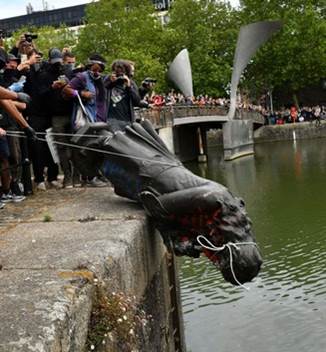 Don't put them on a pedestal
Don't put them on a pedestal
Statue of slave trader Edward Colson removed from its pedestal and being thrown into the port in Bristol, United Kingdom.
One thing Hartwig Fischer must do and preferably as quickly as possible, will be to explain what he meant by his declaration that the removal of the Parthenon Marbles from Athens by Elgin was a ‘creative act.’ Fischer is reported by The Guardian to have declared in an interview with a Greek newspaper: ‘When you move a cultural heritage to a museum, you move it outside. However, this shifting is also a creative act.” The Guardian Does this apply to all removal of artefacts from their countries of origin to Europe and the Western world or only to the act of Elgin? The name of Elgin has been synonymous with vandalism and here comes the director of British Museum who describes this as ‘creative act.’ Does the violent removal of artefacts from Benin to Britain in 1897 also constitute a ‘creative act’? This is decisive for determining the credibility of Fischer’s alleged sympathy and solidarity with Africans, African Americans and Black peoples.
We do not believe in the destruction of statues and other sculptures however offensive and ill-conceived they may appear to us. But why should oppressed people see every day a statute that denies their humanity, mocks them, and thereby also influences others in their attitudes towards Africans and persons with African origins? Why are some persons so concerned by the destruction or removal of statues of slave traders than about the lives of millions of persons killed during slavery and their descendants who still suffer from the results of the nefarious Transatlantic slave trade.? Why should objectionable statues glorifying monsters of history occupy the centre of a city and other public places ? What are their catastrophic effects on children of discriminated groups who have to pass by such objects on their way to school? What effects do such daily painful sufferings have on the mental state of African children and children of African descendants? Those opposing removal of statues of monsters must think about these issues and propose other solutions.
Instead of calling protesters against certain statues ‘vandals’, these courageous youth must be congratulated for tackling head-on the centuries old issue of racism in the Western world that their elders have not always been ready to face and in some cases, did not even want to discuss. What is important to notice is that in most cases the protesters came from all races and classes. This gives us hope that a world free of racism is possible. Those who have failed to act against racism and atrocities are not qualified to criticise the youth for trying to combat racism that has cost millions of Africans, African Americans, and Asians their lives. Black Lives Matter should be considered for the Nobel Prize for Peace.
‘One of the most noble incarnations of a people’s genius is its cultural heritage, built up over the centuries by the work of its architects, sculptors, painters, engravers, goldsmiths and all the creators of forms, who have contrived to give tangible expression to the many-sided beauty and uniqueness of that genius.
The vicissitudes of history have nevertheless robbed many peoples of a priceless portion of this inheritance in which their enduring identity finds its embodiment.
Architectural features, statues and friezes, monoliths, mosaics, pottery, enamels, masks and objects of jade, ivory and chased gold in fact everything which has been taken away, from monuments to handicrafts were more than decorations or ornamentation. They bore witness to a history, the history of a culture and of a nation whose spirit they perpetuated and renewed.
The peoples who were victims of this plunder, sometimes for hundreds of years, have not only been despoiled of irreplaceable masterpieces but also robbed of a memory which would doubtless have helped them to greater self-knowledge and would certainly have enabled others to understand them better.
Today, unbridled speculation, fanned by the prices prevailing in the art market, incites traffickers and plunderers to exploit local ignorance and take advantage of any connivance they find. In Africa, Latin America, Asia, Oceania and even in Europe, modern pirates with substantial resources, using modern techniques to satisfy their greed, spoil and rob archaeological sites almost before the scholars have excavated them.
The men and women of these countries have the right to recover these cultural assets which are part of their being’. A.-M. M’Bow, former Director-General, UNESCO, Paris.(12)
Kwame Opoku.

Looted Ethiopian cross, Magdala, Ethiopia now in Victoria and Albert Museum, London, United Kingdom.
NOTES
1. Hartwig Fischer ,see Annex I
2.K. Opoku, Benin to Berlin Ethnologisches Museum: Are ... - Looted Art www.lootedart.com › news
.K. Opoku, Benin Dialogue Group Removes Restitution of Benin Artefacts ...www.modernghana.com › news › benin-dialogue-grou...
Kwame Opoku: Did Germans Never Hear Directly or Indirectly ...www.africavenir.org › archive › september › article › kw.
“benin Plan of Action For Restitution”: Will This Ensure The ...www.modernghana.com › news › benin-plan-of-action.
3. List of holders of Benin Artefacts-Annex II
4. How often does Nigeria have to ask for artefacts to be returned? www.elginism.com › similar-cases › how-often-dos-nig...
Nigeria demands unconditional return of looted artefacts: A ...www.pambazuka.org › arts-books › nigeria-demands-u
5. 1911 Encyclopaedia Britannica,Volume 19
Negro by Thomas Athol Joyce and Walter Francis Willcox
https://en.m.wikisource.org/wiki/1911_Encyclop%C3%A6dia_Britannica/Negro
6. Black Lives Matter: Race and Equality at the V&A • V&A Blog www.vam.ac.uk › blog › news › black-lives-matter-rac...
7. Loan of Looted Ethiopian Treasures to Ethiopia: Must ...www.modernghana.com › news › loan-of-looted-ethio...
When will the West return Ethiopia's treasures - Elginism
www.elginism.com › similar-cases › when-will-the-wes
On the Ethiopian treasures that are in the British Museum, see www.afromet Ethiopian treasures are also found at the following places in the United Kingdom: The British Library, The British Museum, Duke of Wellington's Regimental Museum, Halifax, Dundee University Museum, Edinburgh University Library, The John Rylands University Library, Lancaster Museum & Priory, National Archives of Scotland, The Schøyen Collection (London/Oslo), The Victoria & Albert Museum and Windsor Castle. More stolen African treasures can be found at the homepage of the African Reparations Movement www.arm.arc.co.uk
8. K. Opoku, To Decolonize Is To Decontextualize, Tristram Hunt. Should ...www.modernghana.com › news › to-decolonize-is-to-d...
9. Excuses for retention of artefacts – Elginism www.elginism.com › similar-cases › excuses-for-retent
Kwame Opoku deconstructs Cuno - Elginism
www.elginism.com › similar-cases › kwame-opoku-dec...
Kwame Opoku: Affirmations And Declarations: Review Of ...
www.africavenir.org › archive › february › article › kw...
Kwame Opoku, Nefertiti, Idia and other African icons in European museums: The Thin Edge of European Morality
News - Looted Art www.lootedart.com › news
10. Kenya's Pokomo people ask the British to return what was ...
www.wvnews.com › newsfeed › international › kenyas-p
K. Opoku, Some Have Waited For 100 Years; Others Are Tired After Few ...
www.modernghana.com › news › some-have-waited-fo
“The British Museum takes its commitment to being a world museum seriously.''
Statement by a British Museum spokeswoman in response to demand by Pokomo people (Kenya) for the return of their looted ancestral drum.
11. Restitution Report: museum directors respond | The Art ...www.theartnewspaper.com › comment › restitution-rep..
K.Opoku, Further Comments On Sarr-Savoy Report On Restitutionwww.modernghana.com › news › further-comments-on...
12. A Plea for the Return of an Irreplaceable Cultural Heritage to Those Who Created It’, A-M. M’Bow, in Lyndel V. Prott (ed.) Witnesses to History-Documents and Writings on the return of Cultural Property, UNESCO Publishing, 2009, p.30.
ANNEX I
A message from Director Hartwig Fischer
‘The British Museum stands in solidarity with the Black community throughout the world. Black Lives Matter. Hartwig Fischer, Director of the British Museum 5 June 2020
The death of George Floyd in Minneapolis is shocking. The subsequent protests, the explosion of pain, indignation, and rage in America and across the world, have brought home how deep the experience of racism is for so many in our societies.
The British Museum stands in solidarity with the British Black community, with the African American community, with the Black community throughout the world. We are aligned with the spirit and soul of Black Lives Matter everywhere.
We stand with everyone who is denied equal rights and protection from violence in the fullest sense of these terms. These are challenges that we as a society must address, injustices that must be overcome.
The death of George Floyd and of many others must sharpen our awareness of how much more we as a major public cultural institution need to do in the fight against inequality and discrimination. We need to embrace the fact that diversity of background, thought, ability and skills are essential for the success of our Museum. And for the heritage sector as a whole.
Inclusion and diversity are at the heart of our values. We will put our best efforts into making them a reality. We will work to diversify our own staff, listening to conversations such as those at last year’s National Programme conference, held at the Museum, which explored equality and diversity in UK museums. We will broaden the diversity of voices present in the interpretation of objects in the collection – we’re currently learning a lot from our collaboration in Manchester Museum’s new South Asia gallery project which is driven by community co-curation. We will continue to research, acknowledge, and address the colonial history of Britain and its impact on our institution in exhibitions like Collecting Histories and Reimagining Captain Cook: Pacific perspectives from 2019. But there is much more to do. In all this we will need to draw on the support of our many long-standing partnerships – with community organisations in our home borough of Camden and beyond, and museums in this country and across all continents. We will move forward together with them as we listen, learn, and act.
And, though it will take time to realise, the Museum’s developing masterplan project provides a unique generational opportunity to reconsider, rethink and rebalance the display of the collection, introducing greater diversity of collections on display, expanding museum narratives. And above all, involving multiple voices.
In the midst of this debate, the extraordinary breadth and depth of the collection continues to challenge us to discover our common human past. We must reach out beyond what we already know. We must believe that we can enlarge our sense of ourselves as individuals and as communities.
Shortly before lockdown, the Museum started a series of public debates on the ‘Era of Reclamation’ led by former Deputy Chair of the Museum’s Trustees, Bonnie Greer. As Bonnie remarks in a blog she published to accompany the series:
Here, inside the British Museum, a theatre of human connection, reclamation can find the seeds that can begin the process of an even deeper, more profound engagement. We need now to see and know that we are the same species, with the same stories. And that we have always been in search of what we ultimately are seeking to reclaim: ourselves
Bonnie has also written a blog reflecting on current events which can be seen here .
Working with partners and listening to both friends and critics, I hope that we will find the right ways to allow the Museum to better reflect our societies and http://www.modernghana.com/ghanahome/columnist/category.asp?menu_id=50&c_id=915 our complex, contentious and blended histories, and become more than ever a theatre of human connection
 Oba Ovonramwen, during whose reign the British looted the Benin Bronzes, with guards on board ship on his way to exile in Calabar in 1897.
Oba Ovonramwen, during whose reign the British looted the Benin Bronzes, with guards on board ship on his way to exile in Calabar in 1897.
Oba Ovonramwen, during whose reign the British looted the Benin Bronzes, with guards on board ship on his way to exile in Calabar in 1897. The flowing gown hides the shackles on his feet.
ANNEX II
LIST OF HOLDERS OF LOOTED BENIN ARTEFACTS
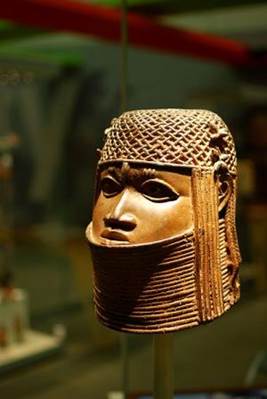 Head of an Oba, Benin, Nigeria, now in Bristol Museum, Bristol, United Kingdom of Great Britain.
Head of an Oba, Benin, Nigeria, now in Bristol Museum, Bristol, United Kingdom of Great Britain.
Commemorative Head of an Oba, Benin, Nigeria, now in Bristol Museum, Bristol, United Kingdom of Great Britain.
Western museums holding looted Benin artefacts appear not to be interested in readers knowing the exact number of the looted Benin artefacts they are holding. Even the Benin Dialogue Group(BDG) does not appear to be interested in the public knowing the exact numbers of Benin artefacts they hold. One could have expected that the major museums would have provided an accurate list of museums and number of Benin artefacts they hold so that we could assess the importance of their proclaimed intention to loan Benin artefacts to Benin/ Nigeria. It does make a difference whether a museum lending one(1) artefact to Nigeria holds two, hundred or five hundred objects. Any pretence of the museums having a mandate or duty to educate the public becomes difficult to sustain in view of this singular failure of informing the public about their looted artefacts.
The following list does not pretend to be exhaustive but aims at giving an idea about numbers of the artefacts some major museums hold so that arguments about the policies of the museum can be measured against numbers. Hopefully, readers in cities where the museums are located would be able to ask a few questions based on this list and above all, ask whether figures given here are accurate and if not, what the correct figures are.
Berlin – Ethnological Museum/Humboldt Forum 508-580.
Boston, - Museum of Fine Arts 28.
Bristol, Bristol Museum 8
Chicago – Art Institute of Chicago 20,
Field Museum 400
Cologne – Rautenstrauch-Joest-Museum 73.
Frankfurt am Main -Museum of World Cultures 51
Glasgow _ Kelvingrove and St, Mungo's Museum of Religious Life 22
Hamburg – Ethnological Museum, Museum of Arts and Crafts 200.
Dresden – State Museum of Ethnology 182.
Leipzig – Ethnological Museum 87.
Leiden – National Museum of Ethnology 98.
Lisbon- Sociedade da Geografia-3
Museu Nacional de Etnologia-3
Museu nacional da Arte Antigua-1
Liverpool- World Museum 40.
London – British Museum 900.
Munich-Museum Fünf Kontinente 25
New York – Metropolitan Museum of Fine Art 163.
Oxford – Pitt-Rivers Museum/ Pitt-Rivers country residence, Rushmore in Farnham/Dorset 327.
Philadelphia -. University of Pennsylvania Museum of Archaeology and Anthropology 100.
Stockholm – Museum of Ethnography 43
Stuttgart – Linden Museum-State Museum of Ethnology 80.
Vienna – World Museum, formerly Ethnological Museum 200.
Zurich-Rietberg Museum 11.
According to Kathy Curnow, the following German cities have each not more than 25 Benin artefacts - Braunschweig, Bremen, Dusseldorf, Freiburg, Göttingen, Hannover, Heidelberg, Hildesheim, Mannheim, and Ulm. Kathy Curnow, IYARE! Splendor & Tension in Benin’s Palace Theatre, 2016, p. 201, WWW.IYARE.NET Printed in the USA by Amazon.com
There are considerable numbers of Benin artefacts in leading American museums and galleries.
 45202074518-j5fqi7t2g0-image009
45202074518-j5fqi7t2g0-image009
Commons/Reginald Kerr Granville
British looters looking at their precious loot. The remains of the metal roof gives an idea of the damage done to the building by the British invaders.
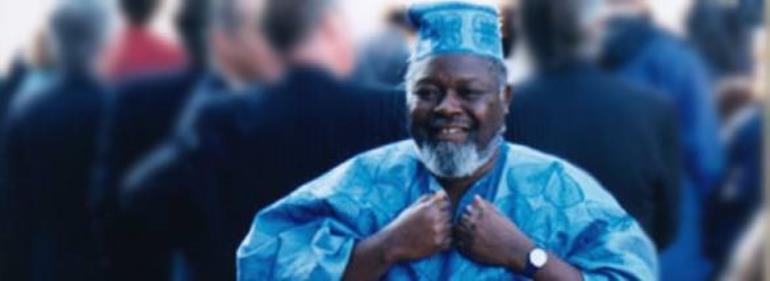 517201752558 image023
517201752558 image023
Bernie Grant, Labour Member of the British Parliament, from 1987 to his death in 2000. Grant urged the British to return looted Benin artefacts. Benin Bronzes Campaign Files | The Bernie Grant Archivehttps://alchetron.com/Bernie-Grant-744944-W. He could have told the British Museum director a lot about solidarity with Africans and sympathy for oppressed African Americans.
 726201865453 image017
726201865453 image017
Asante gold head-dress or ceremonial hat, Kumasi, Ghana, now in British Museum, London, United Kingdom.




 We’ll no longer tolerate your empty, unwarranted attacks – TUC blasts Prof Adei
We’ll no longer tolerate your empty, unwarranted attacks – TUC blasts Prof Adei
 Bawumia donates GHc200,000 to support Madina fire victims
Bawumia donates GHc200,000 to support Madina fire victims
 IMF to disburse US$360million third tranche to Ghana without creditors MoU
IMF to disburse US$360million third tranche to Ghana without creditors MoU
 Truck owner share insights into train collision incident
Truck owner share insights into train collision incident
 Paramount chief of Bassare Traditional Area passes on
Paramount chief of Bassare Traditional Area passes on
 Two teachers in court over alleged illegal possession of BECE papers
Two teachers in court over alleged illegal possession of BECE papers
 Sunyani: Victim allegedly shot by traditional warriors appeals for justice
Sunyani: Victim allegedly shot by traditional warriors appeals for justice
 Mahama vows to scrap teacher licensure exams, review Free SHS policy
Mahama vows to scrap teacher licensure exams, review Free SHS policy
 Government will replace burnt Madina shops with a new three-story, 120-store fac...
Government will replace burnt Madina shops with a new three-story, 120-store fac...
